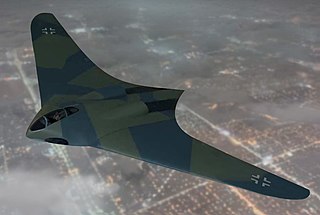
The Horten H.IX, RLM designation Ho 229 was a German prototype fighter/bomber initially designed by Reimar and Walter Horten to be built by Gothaer Waggonfabrik late in World War II. It was the first flying wing to be powered by jet engines.

Walter Horten and Reimar Horten, sometimes credited as the Horten Brothers, were German aircraft pilots. Walter was a fighter pilot on the Western Front, flying a Bf 109 for Jagdgeschwader 26 in the first six months of World War II; he eventually became the unit's technical officer. Reimar was also trained as a Me 109 pilot; however, later in August 1940, he was transferred to the glider pilot school in Braunschweig. He earned his PhD in mathematics from the University of Göttingen, having resumed his studies in 1946 with help from Ludwig Prandtl. The Hortens designed the world's first jet-powered flying wing, the Horten Ho 229.
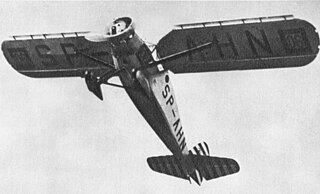
The RWD 6 was a Polish sports plane of 1932, constructed by the RWD team. It was a winner of the Challenge 1932 international tourist aircraft contest.
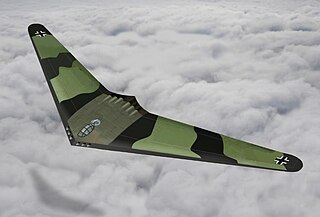
The Horten H.XVIII was a proposed German World War II intercontinental bomber, designed by the Horten brothers. The unbuilt H.XVIII represented, in many respects, a scaled-up version of the Horten Ho 229, a prototype jet fighter. The H.XVIII was one of many proposed designs for an Amerikabomber, and would have carried sufficient fuel for transatlantic flights.

The Horten H.IV was a German tailless flying wing glider in which the pilot was to lie in a prone position to reduce the frontal area, and hence drag. It was designed by Reimar and Walter Horten in Göttingen. Four were built between 1941 and 1943. They were flown in a number of unofficial competitions in Germany during World War II. After the war the flying examples were transported to the United Kingdom and the United States where several contest successes were achieved.
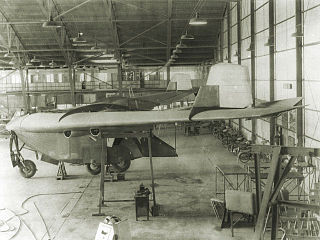
The DINFIA IA 38 was a 1960s Argentine four-engine experimental tailless transport aircraft, designed under the direction of Reimar Horten and based on the German Horten Ho VIII project and built by the DINFIA.
The Horten H.VI was a flying wing aircraft designed by the Horten brothers during World War II.

The SZD-20x Wampir II was a single-seat tail-less research glider designed and built in Poland from 1959.

The I.Ae. 34 Clen Antú, sometimes known as the Horten XVa after its designer Reimar Horten, was a two-seat tailless glider built in Argentina. Two single-seat variants competed unsuccessfully in the 1952 World Gliding Championships.
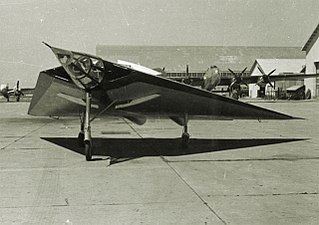
The FMA I.Ae. 37 was a prototype jet fighter developed in Argentina during the 1950s. It never flew and was cancelled in 1960.

The I.Ae.41 Urubú was a two-seat flying wing tailless glider, built in Argentina by the Fábrica Militar de Aviones (FMA) in the 1950s.

The Horten H.III was a flying wing sailplane built by Walter and Reimar Horten in Germany from 1937 to 1944.
The Nike PUL 9 is an Argentine experimental tailless aircraft powered by a Rotax 447 engine.

The DFS Reiher was a single seat competition glider designed in Germany by Hans Jacobs and first flown in 1937. The type won the last two German Rhön gliding championships before the start of World War II. Six were factory produced.

The Horten H.II Habicht (Hawk) was a German flying wing glider built in Germany in 1935. Four, including one flown mostly as a motorglider, were built. One of the gliders was used to test the aerodynamics of a prototype World War II Horten jet fighter-bomber.
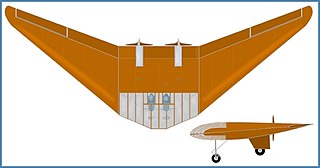
The Horten H.V was a delta-winged, tail-less, twin-engined motor-glider designed and built in the late 1930s and early 1940s by Walter and Reimar Horten in Germany. The H.V aircraft were used for various experimental duties, including: innovative structure, performance, stability and control of flying wing aircraft. The first H.V was the first aircraft to be built using an all composite material structure.

The Horten H.VII was a flying wing fighter-trainer aircraft designed by the Horten brothers in Nazi Germany during World War II.
The Horten H.VIII was a flying wing research aircraft designed by Reimar Horten during World War II and only partly built by the end of the war.

The Horten H.XIII was an experimental flying wing aircraft designed by the Horten brothers during World War II.

The Horten Aircraft HX-2 is a two-seat flying wing or "Blended Wing Body" aircraft powered by a Rotax 912 iS2 engine. It was built and first flown by Horten Aircraft in 2018 as an experimental aircraft. Test flying continued in 2019 at the Kindel Airfield near Eisenach in Germany.


















